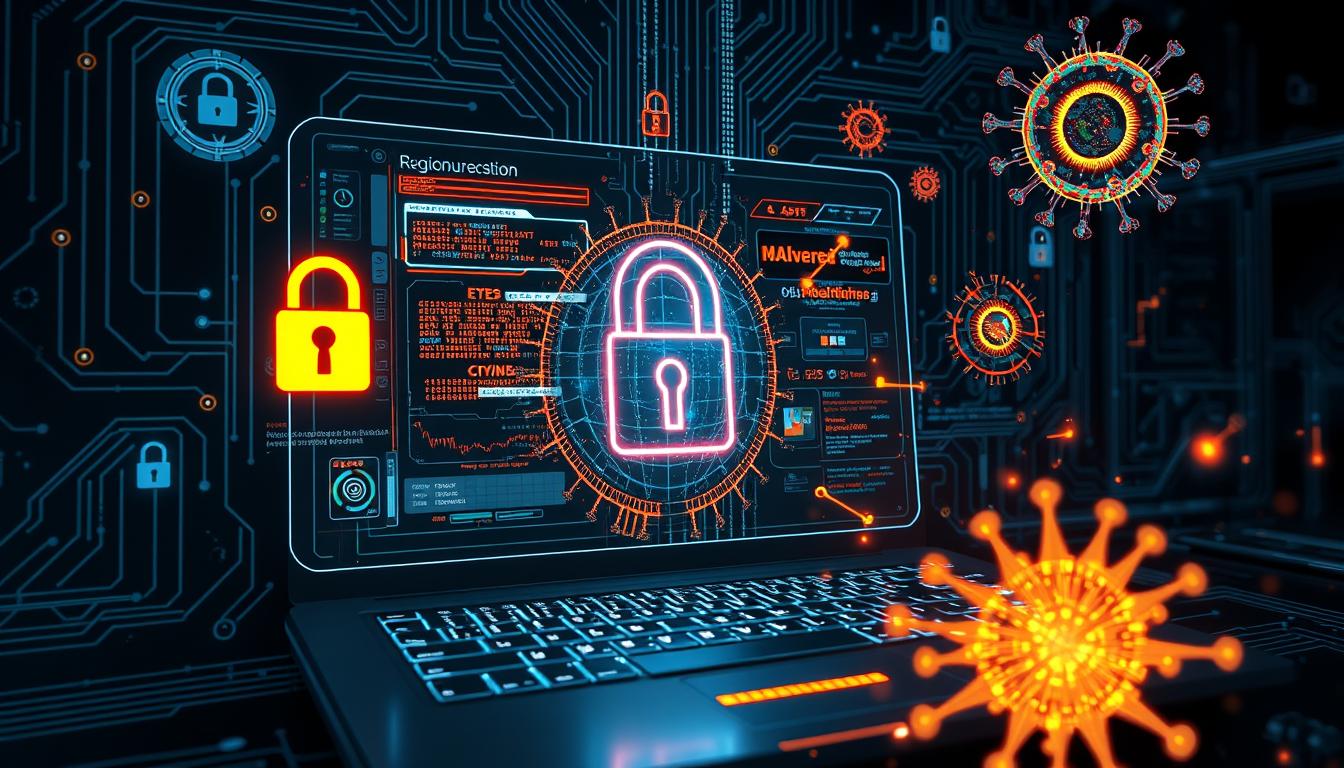3rd Nov 2024
Technology keeps getting better, and so do the tricks of cybercriminals. Lately, the way hackers attack has changed a lot. Now, advanced artificial intelligence (AI) is a big part of these attacks, especially on Gmail users. Experts say these AI hacks are getting smarter, so Gmail users need to be careful and protect their accounts.
The danger of AI hacks on Gmail is growing fast. Hackers use AI to make their attacks seem real and aimed at specific people. This makes it tough for users to spot and stop these threats. It’s key for Gmail users to know about these AI attacks and use strong security to keep their accounts safe.
Key Takeaways
- Gmail users face a rising threat from increasingly sophisticated AI-powered hacks
- Cybercriminals are using advanced AI techniques to make their attacks more convincing and harder to detect
- Staying informed about the latest email security threats and implementing strong security measures is crucial for protecting Gmail accounts
- Vigilance and proactive steps are essential to safeguard against the growing menace of AI-driven email attacks
- Understanding the evolution of AI-powered hacking techniques can help Gmail users better prepare and defend their accounts
Security Experts Warn Gmail Users of More Sophisticated AI Hacks
Recently, security experts have been warning about advanced AI attacks on Gmail. These attacks are getting smarter and harder to spot. Cybercriminals use AI to launch sophisticated hacks on Gmail accounts.
Gmail users now face a bigger risk from AI-driven threats. These include phishing scams, account takeovers, and more. These dangers are tough to spot and stop, making Gmail users’ data more vulnerable.
| Threat | Description | Potential Impact |
|---|---|---|
| AI-Powered Phishing | Cybercriminals use AI to create fake emails that seem real. These emails can trick even the best security filters. | Users might give away their login details or sensitive info, thinking it’s real. |
| Account Takeovers | AI helps hackers act like real Gmail users. They can then get into accounts without permission. | Someone else could take control of your Gmail, steal your data, or scam people. |
| Automated Attacks | AI can find and use Gmail’s weak spots quickly. This makes it hard to keep up with and stop these attacks. | Many Gmail accounts could be hacked at once. This could lead to big data breaches. |
Security experts say Gmail users need to be careful. They should use strong security to protect their accounts from AI attacks.
Understanding the Evolution of AI-Powered Email Threats
The world of cybersecurity is always changing. Advanced persistent threats, powered by AI, are a big worry for Gmail users. Cybercriminals use AI to make attacks smarter and more targeted.
This makes the email world a high-stakes battleground. It’s a place where the risks are higher than ever before.
Machine Learning in Cyber Attacks
Machine learning helps cybercriminals make more advanced email attacks. These algorithms look at lots of data to find weaknesses and craft personalized messages. They also automate getting into email accounts.
This makes it hard for users to tell real emails from fake ones. It’s a big challenge for stopping cybercrime.
Historical Pattern Analysis
Cybercriminals use old data to learn about user behavior and email patterns. They study past attacks to improve their methods. This lets them make more convincing emails.
It’s key for Gmail users to be careful and stay ahead of these threats.
Predictive Attack Modeling
Cybercriminals use predictive models to predict future attacks. These models help them stay ahead of security. They can plan new strategies based on how threats might change.
This makes it hard for Gmail users and security experts to keep up. The fight against AI-powered threats is ongoing.
Gmail users need to stay informed and protect their accounts. Knowing how these threats work helps them defend against them.
Common AI Hacking Techniques Targeting Gmail Accounts
Cybercriminals are using advanced AI to create more sophisticated phishing attacks and social engineering tactics against Gmail users. It’s important to know about these AI-powered hacking methods to keep your online accounts safe.
Advanced Phishing Tactics
AI-driven phishing scams are getting better at looking real. They can send emails that seem to come from people you know, using your own words and style. This makes it hard to tell real emails from fake ones.
Social Engineering Enhancements
Cybercriminals are also using AI to improve their social engineering tactics. They can now have real-sounding conversations to trick you. This can lead to you giving away your login details or letting them into your Gmail account.
| AI Hacking Technique | Description |
|---|---|
| Personalized Phishing | Attackers use AI to analyze user data and craft highly targeted phishing emails that mimic the communication patterns of trusted contacts. |
| Conversational Social Engineering | AI-powered language models enable cybercriminals to engage in natural-sounding conversations to manipulate victims and obtain sensitive information. |
| Behavioral Mimicking | AI algorithms can be trained to mimic the online behavior and activity patterns of legitimate Gmail users, making it easier for attackers to bypass security measures. |
As AI hacking methods get better, it’s more important than ever for Gmail users to stay alert. Make sure to use strong security measures to protect your online accounts.
How AI Makes Phishing Attacks More Convincing
Cybercriminals are using advanced tech, like AI, to make phishing attacks more convincing. They use natural language processing, mimic behaviors, and create messages that fit the context. This makes it hard for Gmail users to tell real messages from fake ones.
Natural Language Processing Advances
AI algorithms can now create phishing messages that seem real. They look at your email history, social media, and more. This way, they can write messages that sound like they’re from someone you trust.
Behavioral Mimicking Capabilities
AI helps cybercriminals act like real email users. They study when you send emails, how long they are, and how you respond. This makes their phishing messages seem like they belong in your inbox.
Context-Aware Message Generation
AI can now make phishing messages that are very relevant and personal. It looks at your emails, calendar, and other data. This way, it can send messages that seem like they’re in response to something you just talked about or an upcoming event.
Gmail users need to stay alert and protect their data and email security. Knowing about the latest phishing tactics and using strong security is key. This helps fight against these advanced cyber threats.
Critical Gmail Security Features You Need to Enable
Protecting your gmail vulnerabilities is key in today’s world. Gmail has strong security features to keep your data safe from data protection threats. Let’s look at the important security steps to take to strengthen your Gmail account.
- Two-Factor Authentication: Turn on two-factor authentication for extra security. This adds a second step, like a code to your phone, to make sure only you can log in.
- Password Manager Integration: Link your Gmail with a good password manager. It creates strong, unique passwords and keeps them safe, stopping hackers.
- Advanced Threat Protection: Turn on Gmail’s advanced threat protection to catch and block bad emails, including AI phishing attacks.
- Security Checkup: Do Gmail’s security checkup often to check your account’s settings, find weak spots, and fix them.
- Desktop and Mobile App Security: Make sure your Gmail apps on desktop and mobile are updated. These updates fix known problems and boost your protection.
By turning on these key security features, you can lower the chance of your gmail vulnerabilities being used and keep your data protection safe from smart AI attacks. Be careful and take steps now to protect your Gmail account.
| Security Feature | Description | Recommended Action |
|---|---|---|
| Two-Factor Authentication | Adds an extra layer of security to your login process | Enable two-factor authentication in your Gmail settings |
| Password Manager Integration | Generates and stores strong, unique passwords | Integrate your Gmail account with a reputable password manager |
| Advanced Threat Protection | Detects and blocks malicious emails, including AI-driven phishing attacks | Activate Gmail’s advanced threat protection settings |
| Security Checkup | Regularly reviews your account’s security settings and identifies potential vulnerabilities | Conduct a security checkup in your Gmail settings |
| Desktop and Mobile App Security | Ensures your Gmail applications have the latest security updates installed | Keep your Gmail desktop and mobile apps up-to-date |
“Protecting your gmail vulnerabilities and data protection is crucial in today’s digital world. Turning on these key security features can greatly help protect your Gmail account.”
Signs Your Gmail Account May Be Compromised by AI Attacks
Gmail users need to watch out for AI attacks on their email accounts. Knowing the signs of a compromised account helps protect your digital and personal info.
Unusual Login Patterns
Watch for unusual login patterns that might mean AI hackers are after your account. Look out for login attempts from unknown devices, locations, or IP addresses. If your login habits suddenly change, it could mean someone else is in your account.
Suspicious Email Activities
Keep an eye on your email for any odd activity. This includes unexpected emails, especially those with attachments or links. AI attacks might send automated replies or messages that don’t sound like you.
Account Setting Changes
Check your Gmail account settings often for any unexpected changes. If your email forwarding, password, or security settings have changed, it could be a threat. Watching these settings closely helps catch and fix email security issues.
Being alert and knowing the signs of AI cybersecurity threats helps protect your Gmail account. The key is to stay informed, monitor your account, and use strong security measures.

Best Practices for Protecting Your Gmail from AI Threats
With AI attacks getting smarter, it’s key for Gmail users to boost their security. This helps protect your digital identity and data protection. A solid plan can lower the chance of falling prey to these threats.
Start by making your Gmail password strong and unique. Don’t use common words or easy-to-guess info. Use a password manager for complex, random passwords. Also, turn on two-factor authentication (2FA) for Gmail. This adds a security layer by asking for a second code to open your inbox.
- Use strong, unique passwords for your Gmail account
- Enable two-factor authentication (2FA) to add an extra layer of security
- Be cautious of suspicious links and attachments in emails, even those that appear to be from trusted sources
- Keep your web browser and other software up to date to take advantage of the latest security patches
- Monitor your Gmail account for any unusual activity or unauthorized access attempts
Also, be careful when you’re online and checking emails. Watch out for dodgy links and attachments, even if they look like they’re from people you know. Keeping your browser and software updated is also crucial. This helps fix known security issues.
Keep an eye on your Gmail for odd activity. Look out for login attempts from places you don’t know or changes to your settings. By being proactive and following these tips, you can greatly improve your Gmail’s cybercrime prevention and data protection against AI threats.
Advanced Security Tools and Solutions for Gmail Protection
Gmail users face a growing threat from AI-powered hacking. To protect their accounts, they need strong security tools and solutions. These include third-party apps, advanced authentication, and monitoring tools. A complete strategy is vital to fight off email security breaches.
Third-Party Security Applications
Many third-party security apps offer extra protection for Gmail users. These apps use AI to spot and stop suspicious activities. They block harmful emails and analyze threats in real-time. Adding these apps to your Gmail can greatly boost your email security.
Authentication Methods
It’s important to make your Gmail account more secure against AI hacking. Using two-factor authentication, security keys, and biometric verification helps a lot. These steps can stop unauthorized access and keep your emails safe.
Monitoring Tools
Keeping an eye on your Gmail account is crucial to catch security threats early. Special monitoring tools track login activities and email changes. They alert you to potential problems, so you can act fast to protect your data.


